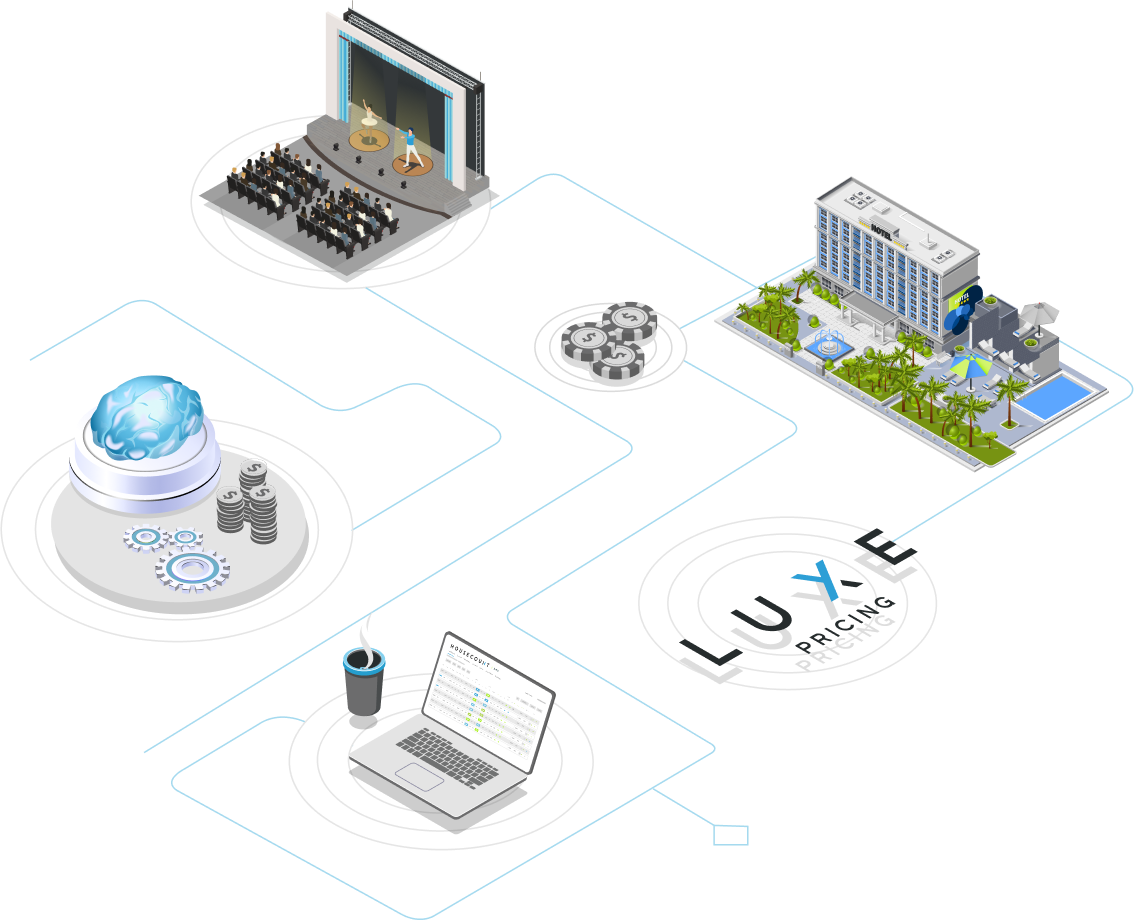What Is Revenue Maximization and Why Does It Matter in Hospitality
Full service hotels have an average daily expenditure of $41,000. But what if there was a way to reduce those expenses...

Table of Contents
Revenue available per room (RevPAR) is an essential metric used in the hospitality industry to measure a hotel's overall performance. Every hotel has to deal with the delicate balance of trying to ensure that the occupancy rate is high while at the same time trying to extract as much revenue as possible from each room.
By paying attention to RevPAR, hotels can more accurately keep track of this balance and take the appropriate actions needed to maximize profits.
This guide details what RevPAR is, how to utilize it, and how to improve it for your property.
RevPAR, or revenue per available room, is one of the most important KPIs used by hoteliers in the industry for tracking, monitoring, and assessing business and financial performances.
Although RevPAR is a metric that accesses a hotel’s average ability to fill rooms, it doesn’t necessarily mean revenue is increasing. Instead, a positive RevPAR metric means that the hotel’s average room occupancy rate is improving.
You can use two main formulas in calculating RevPAR:
The first formula is better suitable for hotels with limited but fully-occupied rooms. That’s considering these rooms are also unavailable because the formula only accounts for the total occupancy and not the total availability.
On the other hand, the second formula is applicable to hotels with available rooms that are not currently occupied. Other formulas will yield dollar amounts that are hypothetically lower than the hotel’s actual daily rate. This is because it’s impossible for hotels to be occupied for more than 100%.
Let’s say your hotel has an occupancy percentage of 70%, and the average daily rate is $100. This makes your RevPAR $70. When using the other formula, you need to identify your hotel's total number of rooms.
If your hotel has 300 rooms, a 70% occupancy rate means 210 rooms are occupied. The total revenue will be $21,000 after multiplying 210 rooms by 100. Divide $21,000 by 300, which is the total rooms available in your hotel, and you’ll get $70 as the RevPAR.
It’s important to note that RevPAR doesn’t consider the overall size of a hotel, so it’s not a good metric to measure the hotel's overall performance by itself. For instance, a hotel may have a lower RevPAR, but have rooms that are priced higher (such as penthouse suites or other types of rooms) that generate more individual revenue, compensating for lower-priced rooms that didn’t sell.
RevPAR should never be used as a standalone metric for determining your hotel’s overall revenue streams and financial health. Together with this key metric, other important determinants can help you generate better revenue strategies and business decisions.
We’ve provided a table summarizing the other key metrics you should use in addition to RevPAR to ensure proper revenue management for your hotel.
|
Key Metric for Revenue Management |
Main Purpose |
|
ADR |
Stands for Average Daily Rate and measures the average revenue earned for an occupied room per day. |
|
TRevPAR |
Computes a hotel’s available space and the generated total revenue for the occupied rooms |
|
RevPAC |
Can help make accurate predictions of your hotel’s revenue in a year |
|
GOPPAR |
Can give you an idea of how well your hotel’s each department is performing |
|
CPOR |
Can help hoteliers understand how profitability works |
|
ARPAR |
Factors your hotel class, seasonality, and property location |
|
NOI |
Computes for your hotel’s profitability by factoring in establishment expenses |
RevPAR can help you determine how you can fill in all your hotel’s available rooms depending on an average rate. An increasing RevPAR generally means your occupancy and average room rates are both increasing.
But it’s important not to confuse RevPAR with ADR (which we’ll discuss in more detail later in this article).We know they both give you ideas about your establishment’s room revenues, but they differ entirely. Moreover, calculating RevPAR is impossible without computing the ADR.
ADR, or average daily rate, gives you an overview of your hotel's revenue from each sold room. This differs from RevPAR, which informs you of the total gain for all the occupied spaces.
RevPAR is the more valuable of the two because it goes beyond looking at your daily rate. Daily occupancy should also be observed, which RevPAR involves for a much better accurate assessment. When considering RevPAR, the more rooms sold at higher daily rates, the higher your revenue becomes.

TRevPAR, or the total revenue available per room, assesses a hotel’s total revenue amount by looking at the performance of each room. This key metric does not consider whether the rooms are occupied or sold.
This KPI gives hoteliers a bigger picture of how the spaces in the hotel are used to generate better revenue and profitability. Generally, increasing TRevPAR indicates an overall increased average revenue and occupancy. Analysts use this formula to calculate TRevPAR:
TRevPAR = Total Revenue divided by the number of available rooms.
The main difference between TRevPAR and RevPAR is that the former factors all the revenue from all the rooms aside from the room rate. It can give hoteliers a more in-depth view of the picture, helping hoteliers adjust prices when needed.
As the name suggests, RevPAC is all about getting the total revenue each customer generates. The formula for this metric dividing the total revenue from all customers by the number of customers visiting your hotel. Computing your hotel’s RevPAC means getting the average revenue.
Your hotel’s RevPAC is most useful when identifying revenue predictions for an entire year. Another benefit of RevPAC is that it allows your hotels to become more customer-centric. You can use information from this crucial metric to generate ways to improve your clients’ overall experience in your hotel.
Improving your hotel’s RevPAC should always be part of your business goals, but you must include all departments involved. These departments can include the following:
GOPPAR, or gross operating profit per available room can be a tricky indicator, but it’s an important one. It helps reflect all the performances of your hotel’s departments by generating your establishment’s overall profits. These include all your drink and food-related sales, as well as other additional amenities your hotel offers.
The main formula for computing GOPPAR is to get the overall profit of your hotel and divide it by the total number of rooms. GOPPAR is mainly a profit indicator that relies on a hotel’s revenue but not including the costs. But because GOPPAR is merely an overall daily metric indicator, you must combine this with other key metrics to become more reliable.
CPOR, or the Cost per Occupied Room, measures each occupied room costs a hotel by dividing all operating expenses by the total number of occupied rooms. Let’s say five of your rooms are occupied. If your hotel’s total operating expenses reach $1700, your CPOR is $340.
CPOR is essential because it helps track your establishment’s overall expenses. Most hoteliers also use this to determine how much the minimum rate is per room, allowing you to adjust your prices to ensure you’re still getting profit.
You must also remember that hotels generally have two main types of expenses or costs:
ARPAR, or adjusted RevPAR, takes more factors into account than the standard RevPAR. Because modifications are made, you can expect better views of your hotel’s profitability with ARPAR. Moreover, the most critical factors you must consider when computing ARPAR are:
Similar to RevPAR, you must determine your ADR metric to calculate ARPAR. Divide your total revenue from room sales by how many rooms are sold. Subtract variable costs from the quotient, add additional revenue, and multiply by your total occupancy.
ARPAR = (ADR - Each room’s variable costs + each occupied room’s additional revenue) * the total number of rooms occupied
And because ARPAR is as relevant as RevPAR, hoteliers constantly seek ways to increase this key metric. You can increase and improve your hotel’s ARPAR via the following ways:
NOI, or net operating income, determines how your property is performing in relation to whether it’s making profits or losing money. Computing this key metric involves subtracting your operating expenses from your hotel’s total revenue.
Let’s say you made $4000 in sales from your rooms, spa, and restaurant. If your gross expenses reach $1700, your daily NOI will be at $1800. Determining your net operating income is essential to keep track of your daily expenses. This KPI can actively determine how your property can continuously generate profit.
No matter how useful RevPAR is in hotel management, you won’t be able to maximize its benefits without combing it with other metrics. Aside from the key indicators mentioned above, there are other helpful KPIs that can track your hotel’s performance.
Average Daily Rate (ADR) can calculate your hotel’s rental revenue at an average, depending on your occupied rooms in a specific time duration. Simply divide the total room revenue by how many rooms are sold.
One reason to use this performance indicator is that it can help you identify how much money you’re making per room. It’s also easy to monitor your hotel’s ADR over time. You can compare your ADR with your competitors and generate better pricing strategies.
However, ADR also has its limitations. This metric should not deceive you because it’s only one side of a story. ADR does not consider the following:
The average daily rate can be useful by itself. Still, you need other metrics like RevPAR to understand your hotel’s current financial and business conditions.
Revenue Generated Index (RGI) is another key performance indicator hoteliers should take advantage of. It compares the RevPAR of your hotel with the standard RevPAR in the industry. This way, you can quickly gauge whether you’re gaining good revenue compared to your competitors.
To compute your hotel’s revenue-generated index, follow the step-by-step guide:
The revenue generated index lets you understand the market's current condition, especially of your competitors. This way, you can improve your pricing strategies to be better than other hotels in the exact location.
An RGI greater than 100 means your hotel is performing well. You should also be proud because it generally means your hotel is better than your competitors. At the same time, an RGI score of less than 100 means your establishment needs improvements. You must generate ways to boost your occupancy and improve your pricing strategies.
Working on your RevPAR for more successful hotel management means increasing overall revenue. This will be good for your hotel’s profitability and branding.
At the same time, increasing your RevPAR can help you generate fewer expenses that can affect your overall revenue.
Several ways can help hoteliers improve their RevPAR, and we have summarized some of the most effective strategies below.
|
Method |
Benefit |
|
Increase average daily rate |
To attract more customers and increase your daily revenue |
|
Increase occupancy |
Give clients more reasons to visit your hotel and stay |
|
Implement different pricing strategies |
Offer flexibility that can improve your hotel’s convenience |
|
Manage your online reviews |
Keep up with customers who prefer checking reviews online before booking hotels |
|
Take advantage of technology |
Technology makes everyone’s lives easier. This makes it faster for clients to locate your hotel and book a room. |
|
Run loyalty programs |
Convince return customers to stick to your hotel and attract potential new clients |
Increasing your hotel’s average daily rate involves actively yielding on various room types and constrained dates using tools like HouseCount RMS. This platform has two main goals:
Another great strategy to help increase your average daily rate is to upsell guests into booking higher room categories. You must be able to present them with the best advantages and features they can enjoy when availing of the upsell.
LuxSell URS is one of the most effective platforms for upselling. It monitors real-time property data to provide the best available offers to give you dynamic pricing strategies across all types of inventory.
We know the seamless transactions you can create with online travel agencies. Plus, these platforms help hotels gain a more significant number of customers and guests. But one thing you must know about OTAs is that they charge high commissions. And these fees can decrease your overall total revenue.
This is why gaining sales from a direct hotel website is more profitable. Direct bookings don’t charge additional fees and commissions, so you get the money as is.
From upsell opportunities to accurate price management, Luxe Pricing is here to maximize your revenue.

Hoteliers can increase occupancy by identifying off-season periods when they can decrease prices and open price-worthy offers for new and returning customers. For instance, HouseCount RMS is a platform you can rely on to generate better pricing strategies for your hotel, especially during quiet periods.
At the same time, you can also upgrade more rooms, freeing up more standard inventories to make more bookings available. This allows you to broaden your target customers and increase your overall sales.
Moreover, you can improve your hotel’s occupancy by receiving bookings from various channels, including online travel agencies and wholesale and direct hotel websites.
It’s now a general fact that the average daily rate is directly proportional to RevPAR. Increasing your ADR also means expanding your RevPAR. But you must know that hiking your room rates is not always the best solution. If you keep upselling your rooms, you’ll have an unsalable property.
This is why formulating strategic approaches is an excellent practice for increasing room rates. It includes having different pricing strategies depending on the season, weekdays, and weekends.
You can also leverage various customer segments to generate better room rates. These customer segments can include leisure travelers and business travelers.
Nowadays, 81% of travelers base their bookings on reviews they read online, making online reviews critical to a hotel’s success. You must leverage these travelers and ensure your hotel has a positive online reputation. Plus, this can add to your brand’s overall value and trust.
Your online image can directly impact your hotel. Therefore, you must keep track of all reviews made online – the good and especially the bad. Learn to deal with negative comments and use them as constructive criticisms to improve your hotel management.
Moreover, you must reply to reviews in real-time. Punctual feedback makes your guests confident that you care for your brand and customers’ experiences. This increases the chance of more guests returning and rebooking a stay at your place.
Taking advantage of technology means making it easy for guests to do everything online. This includes booking a room, talking to customer support, and obtaining the information they need regarding dining options and available amenities.
The best ways to leverage technology include the following:
Running loyalty programs can increase your RevPAR and occupancy rate. These promotional programs attract old and new guests to try out your brand and book their stays.
When deciding to establish loyalty programs, take note of the rewards you offer your guests. They should contain real value to allow your guests to feel special. Plus, it’s better to provide them with a reward on their next visit than to reward them only after reaching a certain amount of loyalty points.

As with most critical metrics, one of the most strategic ways to improve your hotel’s RevPAR is to rely on reputable software solutions. Aside from being convenient and flexible, the software provides you with the automation you need, saving you valuable time to accomplish other tasks in hotel management.
Additionally, a robust software solution can help you strategize on finding the best room price. This can help you maximize profitability without compromising the quality of service and amenities you provide to your guests.
When it comes to choosing the most suitable software solution for your hotel, several variables should be considered:
Luxe Pricing is an upscale software solution for boosting your RevPAR and overall revenue and profitability. This platform’s RMS is always up-to-date with the current trends in the market, giving your hotels the best pricing solutions to attract old and new guests. Luxe Pricing is unique because it ensures the solutions it suggests are based on precisely what you prefer.
Aside from increasing your hotel’s RevPAR, Luxe Pricing also features several other benefits:
More importantly, because Luxe Pricing utilizes Artificial Intelligence, everything is real-time with this software solution. This makes it easier to track, monitor, and assess your hotel’s performance in relation to your competitors.
Utilizing RevPAR is critical in the hotel industry because this key metric helps gauge your establishment’s financial performance. This performance indicator can allow you to assess your hotel, compare it to your competitors, and generate ways to improve your operations.
Despite the importance of this particular KPI, remember that RevPAR does not work alone. You’ll also need to rely on other relevant metrics like occupancy rate, RGI, ADR, NOI, ARPAR, CPOR, and more. These KPIs are all essential to help you establish better pricing strategies that can be good for your profitability.
You can help improve, meet, and track these types of KPIS by using accurate pricing and upselling software. Luxe Pricing offers two such software that can help you achieve those goals, including HouseCount RMS and LuxSell URS. Request a demo to see how these platforms work in action and how they can benefit your hotel’s bottom line.
From upsell opportunities to accurate price management, Luxe Pricing is here to maximize your revenue.





Get Hooked! Sign Up to get the latest catch sent to your inbox.
Full service hotels have an average daily expenditure of $41,000. But what if there was a way to reduce those expenses...
Making sure that “the price is right” can be pretty tough, whether it’s a hotel or another business. Unfortunately, an...
The aftermath of the pandemic has left many hoteliers with depressed earnings and lost revenue. At this stage, business...